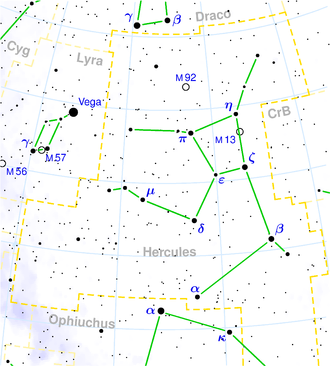IC 1220
| Galaxie IC 1220 | |
|---|---|
![IC 1220[1]](http://upload.wikimedia.org/wikipedia/commons/thumb/d/dd/IC1220_-_SDSS_DR14.jpg/300px-IC1220_-_SDSS_DR14.jpg) | |
| IC 1220[1] | |
| AladinLite | |
| Sternbild | Herkules |
| Position Äquinoktium: J2000.0, Epoche: J2000.0 | |
| Rektaszension | 16h 29m 38,296s[2] |
| Deklination | +08° 27′ 02,63″[2] |
| Erscheinungsbild | |
| Morphologischer Typ | E[2] |
| Helligkeit (visuell) | 14,0 mag[3] |
| Helligkeit (B-Band) | 15,0 mag[3] |
| Winkelausdehnung | 1,00' × 1,0'[3] |
| Flächenhelligkeit | 13,8 mag/arcmin²[3] |
| Physikalische Daten | |
| Rotverschiebung | 0.032973 ± 0.000097[2] |
| Radialgeschwindigkeit | 9885 ± 29 km/s[2] |
| Hubbledistanz vrad / H0 | (446 ± 31) · 106 Lj (136,6 ± 9,6) Mpc [2] |
| Geschichte | |
| Entdeckung | Lewis Swift |
| Entdeckungsdatum | 21. Juli 1890 |
| Katalogbezeichnungen | |
| IC 1220 • PGC 58340 • CGCG 052-030 • MCG +01-42-005 • 2MASX J16293826+0827023 • GALEXASC J162938.17+082701.8 • NSA 147054 • WISEA J162938.30+082702.6 | |
IC 1220 ist eine elliptische Galaxie vom Hubble-Typ E0[3] im Sternbild Herkules am Nordsternhimmel. Sie ist schätzungsweise 446 Millionen Lichtjahre von der Milchstraße entfernt und hat einen Durchmesser von etwa 130.000 Lichtjahren.
Das Objekt wurde am 21. Juli 1890 von Lewis Swift entdeckt.[4]
Siehe auch
Weblinks
Einzelnachweise
Auf dieser Seite verwendete Medien
Autor/Urheber: Sloan Digital Sky Survey, Lizenz: CC BY 4.0
The sky image is obtained by Sloan Digital Sky Survey, DR14 with SciServer.
Angle of view: 4' × 4' (0.3" per pixel), north is up.
Details on the image processing pipeline: https://www.sdss.org/dr14/imaging/jpg-images-on-skyserver/



